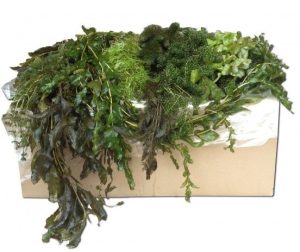Oxygen plants in your pond. An important resource for a clean pond.
Oxygen plants, why are they important in your pond?
Humans cannot live without oxygen. Most other life forms also need oxygen. This naturally also applies to the organisms in your pond. It is therefore important that there is sufficient oxygen in the water. Oxygen can enter the water in various ways:
Artificially
This can be done via an air pump or fountain, for example. By blowing in air or splashing the water on the surface, oxygen dissolves in the water. In shallow ponds without many aquatic plants, aerating in this way in summer can prevent fish from dying. In larger water bodies or ponds, a large aerator is often used. This is usually done on or after several warm days. This is because less oxygen can dissolve in warm water, which can cause problems.
Naturally
Exchange between the air and the water provides limited oxygen to the water. In larger water bodies, wave action and wind impact are additionally an important oxygen provider.
Oxygen is produced by aquatic plants under the influence of sunlight. Just as trees and plants do on land, so do oxygen plants that underwater. Adding aquatic plants to your pond contributes to a healthy oxygenation ratio. However, there are other benefits to your pond:
Frequently asked questions
What are the benefits of oxygen plants in your pond?
- Oxygen plants add oxygen to the water.
- Provide food; several species are edible for fish.
- Making and keeping the pond clear.
- Preventing or containing algae through competition over nutrients.
- Enhance the attractiveness of your pond with flowering species.
- Production of oxygen by aquatic plants.
Oxygen plants are indispensable in aquariums and ponds. This is because, as their name suggests, they add oxygen to the water. This happens through a process called oxygenic photosynthesis. Under the influence of sunlight, glucose and oxygen are formed from water and CO2 (more info: Wikipedia). Oxygen is essential for (aquatic) life, such as fish and other pond or aquarium inhabitants.
Are oxygen plants edible?
Some aquatic plants, such as Waterweed, are edible for fish and can partly meet the food needs of pond inhabitants. There are also aquatic plants edible for humans. Watercress is an example of this. Sometimes, on the contrary, people want plants not to be eaten by fish. Plants such as crab crab are then an option.
Can oxygen plants restore clarity to my pond?
Besides producing oxygen and providing food, an important advantage of oxygen plants is that they ensure a clear pond. Suspended matter, which makes for a murky pond, is often largely organic in origin and can be used by aquatic plants as nutrients. Plants such as Waterweed and Hornleaf absorb many of these nutrients from the water as they grow, filtering the pond water, as it were. In addition, some oxygen plants have special properties that purify the water even more effectively. Hornwort, for example, as well as Shiny Pondweed, secretes a substance that makes algae grow less. We call this allelopathic.
Are oxygen plants a solution to algae growth?
A common problem in ponds is the rapid growth of algae. The pond can quickly turn green when it warms up quickly and the sun is shining. This is because algae can grow very explosively in nutrient-rich water and cause what is known as an algae bloom. The water is then full of (filamentous) algae and will not look attractive. Nutrient-rich water can be caused by feeding fish, for instance, but fish excrement also contains a lot of fertiliser. Fast-growing water plants such as Waterweed and Hornleaf compete with the algae for nutrients, reducing the chances of an algae bloom.
How should I plant oxygen plants in my pond?
To get optimal results from oxygen plants, it is advisable to use about 4 to 5 bunches per 1000 litres of water. This may seem like a lot, but to prevent algae blooms and to get the best clarity in the pond, this is really necessary. The best, and of course the most fun, is to use a variety of species. As a result, there is always a species that bears beautiful flowers or grows optimally.
You need to be careful which species you put where. Some species need to be planted in a pond basket, such as Waterweed or Glossy pondweed, while others float freely in the pond, such as Hornleaf or Crabgrass.
Buying oxygen plants?

Are you curious what oxygen plants can do for your pond? We have had good experiences with De Vijvermeester's oxygen plants. They have beautiful bunches of high quality. The button below takes you straight to the webshop.
